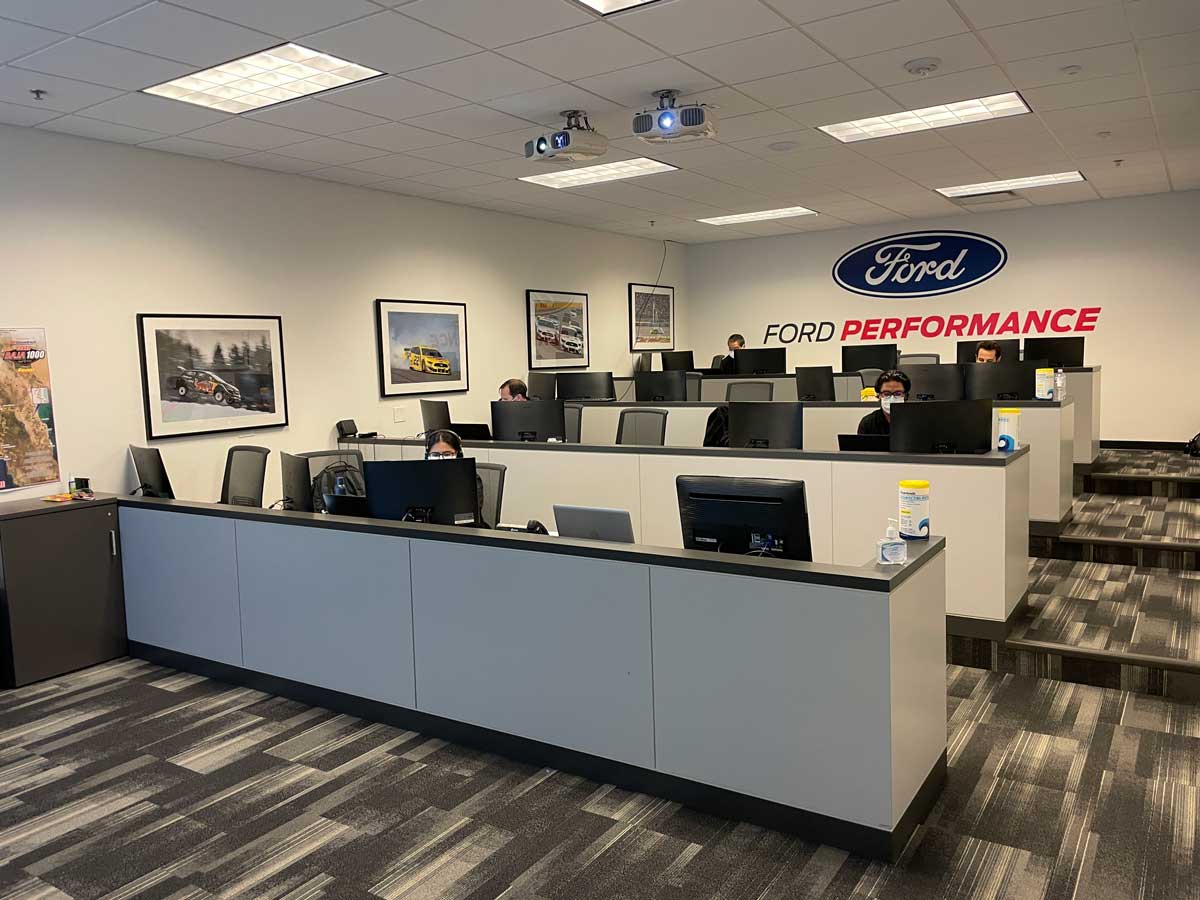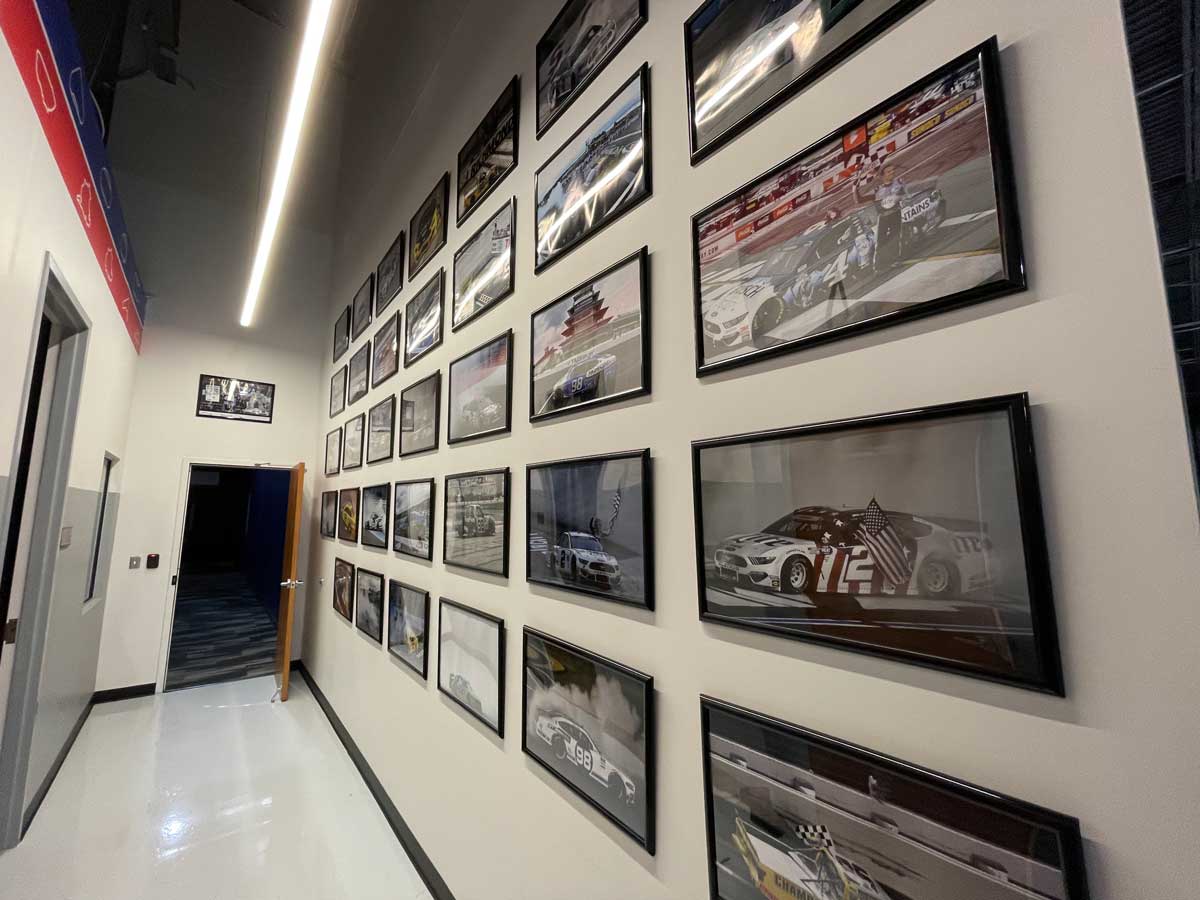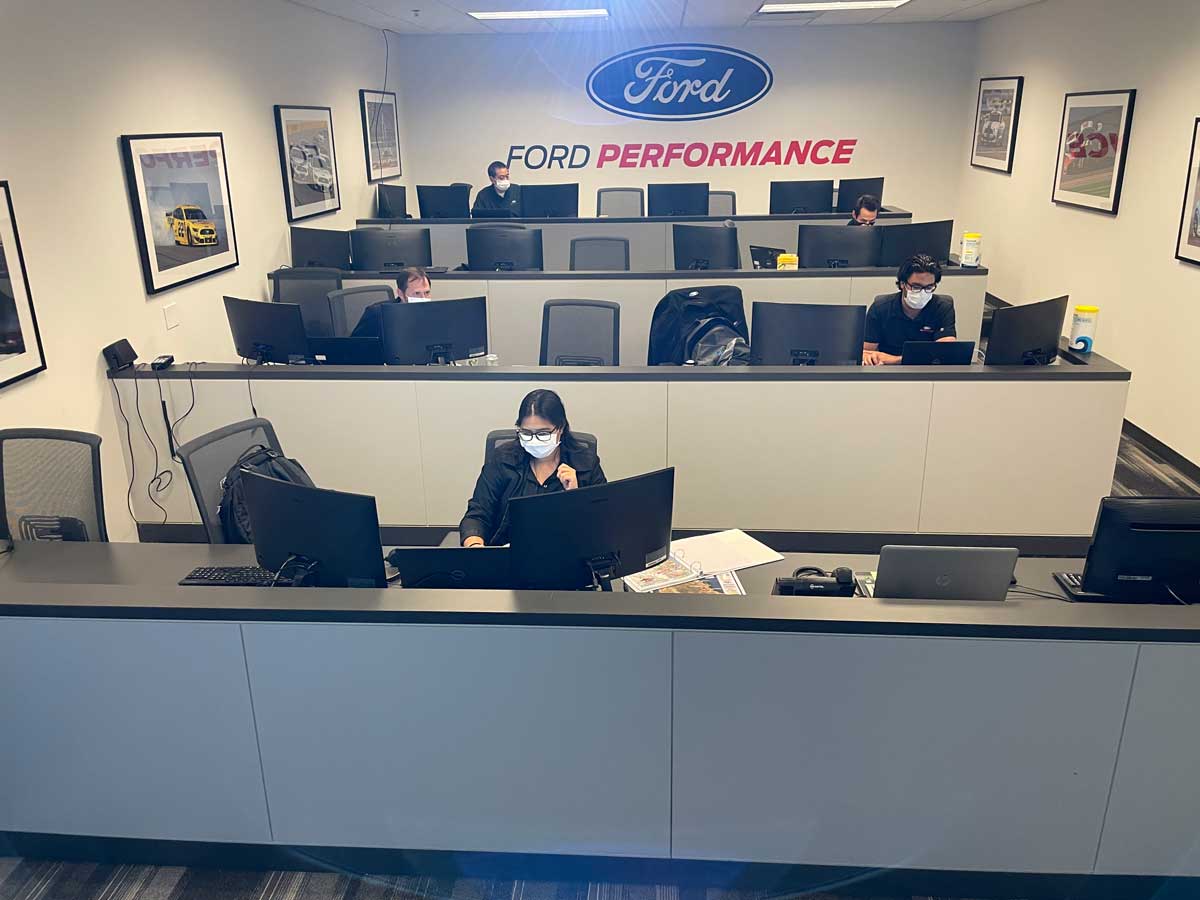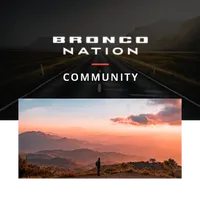The Baja 1000 is a grueling race that takes an experienced array of drivers as well as a strong crew supporting an effort just to reach the finish line. Traditionally, most teams would have people on site somewhere on the Baja peninsula in order to support a race vehicle but Ford went virtual this year and supported the Ford Bronco R and the crew on the ground from 2,400 miles away in North Carolina.
Passing by the Concord Mills outlet mall and through a subdivision brought me to the business park that contains the Ford Performance Technical center in Concord, North Carolina. While it may have looked like your average business park on a Friday evening, the other side of the door on the building marked with Ford Performance revealed a lively command center that felt like it could have been located in the middle of Baja.
The lobby of the Ford Performance Technical center quickly gives away the exciting nature what’s contained within as a Supercars Ford Mustang is the first thing you see once you enter with a Ford GT EcoBoost engine sitting across the way once you turn left. After passing through a variety of interesting race car parts and memorabilia we end up in a large conference room located across from one of their driver-in-the-loop simulators. This conference room contains the engineering team that is supporting the Bronco R race effort live during the entire Baja 1000 race.
Many of those in this room would usually be on the ground in Baja but pandemic restrictions have limited the amount of people that can travel so Ford Performance assembled this remote team with a variety of skills and experience to assist in the effort. The team ranges from newly minted engineer Valeria Rosado-Mojica all the way up to the Global Director of Ford Performance Motorsports Mark Rushbrook and everyone plays an important part.
Valeria Rosado-Mojica is an off-road engineer that is the newest part of the team and has joined them as part of the Ford College Graduate Program or FCG. The FCG program is a rotational program for new members at Ford that exposes them to a variety of roles and allows them to see everything from the factory to floor to various design and engineering departments. She is starting out in the motorsports department and will work with this team before being rotated to various roles over the next two or three years before eventually returning here to use her new skillset. Like many with a motorsports focus, she studied mechanical engineering in college and participated in Formula SAE which allows her to bring a lot of motorsports engineering knowledge even as the newest member of the team. She sits at the front of the room and tracks the Bronco R while recording speeds to help create analysis of how the truck will progress as the race goes on.
Rosado-Mojica reports to Brian Novak who sits directly behind her in the command center. He is a Motorsports Supervisor for Ford Performance and dips into just about every type of motorsport that Ford participates in from Supercars to NHRA drag racing. He is currently responsible for the Bronco R along with other projects such as the Mustang Mach E 1400. He leads this remote base at the Tech Center for the Baja 1000 and was the primary point of contact with the personnel on the ground in Baja.
All of the data that comes in from the field is analyzed by Alex Gehrke who is sitting in the row behind Novak in the command center. He brings a wealth of experience in data analysis with him having participated in the Ford GT program in IMSA and WEC as well as being involved in the Mustang Mach E 1400 project among many others. Most recently he used feedback from the drivers and data from the car to make modifications for the Mustang Mach E 1400 to improve how it drives both in drift and road course configuration. At the command center, he takes in all the speed, distance, and fuel data from the Bronco R and charts it along with making predictions with how the truck will perform as the race goes on.
In the last row sits, Tadahiro “Tad” Ohtake and his responsibility is similar to the others with supporting communications effort to the Bronco R but his background in simulation helps to make predictions and examine issues when they pop up during the race. Ohtake runs a team of 13 people in his daily work for Ford Performance which are split between North Carolina and Michigan and are responsible for simulation. Ohtake and his team have worked on many simulation projects using the two driver-in-the-loop simulators that Ford owns ranging from NASCAR all the way to road car simulations. Ohtake shared that one of their simulators is now used for road car simulations for the majority of the time that it is scheduled. He also shared that they are worked on mapping more advanced terrain and hope to have more off-road simulation available in the future.
Everyone is invested in the success of this program and that goes all the way to the top so rounding out the technical group on site is Mark Rushbrook who is the Global Director of Ford Performance. His role is to lead the Ford Performance group but during this race it is like that of many of the others as he helps to decipher the communications coming from the race as well as bounce ideas back and forth when planning or troubleshooting is necessary.
Communication is not only inside the race team as communication pro David Baltazar is also in the command center to work with the technical team in order to communicate what’s happening in the race to fans and owners over social media so they can keep up with the Bronco R during the race.
Lots of effort goes into logging what the Bronco R is doing on course and using that information to analyze how the race will progress. They log every possible mile and use that information to estimate things like fuel usage and average speed to figure out the best way to get to the finish. They are aided in working on this information by a variety of resources which start out with a pretty standard tool called The Weatherman Relay. This is a radio relay station set up in Baja that allows everyone to communicate on a public frequency and is a primary source of information for course conditions. Not only do the teams and officials communicate over this public frequency but even fans with radios will share if they spot an issue or obstruction on the course.
Past the public resources, Ford employs a satellite communications device called MSAT that allows the command center to communicate directly with the drivers in the truck as well as with the drivers in one of the 17 chase vehicles that are deployed around the course. Ford uses vehicles from their fleet for this support and the chase vehicles are primarily F-150 Raptors and F-250 Tremors. In addition to MSAT, standard text messaging is used to communicate with the engineers and team leads in Baja along with a team chat that allows for easy sharing of photographs or other information.
All of these communication devices came into play as a steering issue popped up a few hours into the race. The driver communicated a shudder from the steering in certain turns and the group in North Carolina kicked into gear right away. The first task was for Novak to reference the documentation for how the power steering rack is powered and relay where the power reset is to the driver of the Bronco R. While all of that was going on, communication to the nearest chase truck started and plans for a replacement steering rack were underway.
As the power reset was not successful, the steering rack replacement had to be completed and while that was going on, photos from the site were streaming back to the control center so that the personnel there could examine the condition of the truck and if any additional changes needed to be made. The repair was completed and the Bronco R went on it way down the course while the group in North Carolina logged what was completed as part of the notes for the race effort.
These logs are a direct part of the larger picture as to why the Bronco R is participating in Baja at all because the logs and data from this race are used directly to improve the roadgoing Bronco. It may seem odd at first to use data form the race truck and translate it to a roadgoing vehicle but the Bronco R actually uses the 2.7-liter EcoBoost engine, 10-speed transmission, powertrain control unit, and much of the gearing from the roadgoing Bronco which makes the information very relevant.
The Bronco R and the chase trucks above are equipped with WIFI that is interfaced with that OEM powertrain control unit so when the chase trucks are close enough to the Bronco R they can actually connect and pull logs from the truck wirelessly. These logs are sent up to the cloud where the group in North Carolina can examine them during the race along with engineers in Michigan and they are later transferred to the group developing the calibrations for the roadgoing vehicle in order to make improvements to the Broncos that end up on dealer lots. In addition to the factory powertrain control module, they also employ some electronics from Motec, mostly for power management and in order to log additional sensor data in order to paint a better picture of what the Bronco R goes through on course.
The various communication methods and types of data that flow from the race add up to dozens of different variables that are monitored actively throughout the race but most importantly they provide a large amount of data that engineers can use to make improvements for the future. The team in Charlotte spent over a day straight monitoring the race and supporting the truck and they were rewarded as repairs went smoothly when needed and the truck finished the race which was their biggest goal for this weekend. The MSAT communication came in key as the last miles of the race came down as navigator Richie Brugger was able to provide regular updates to the team in North Carolina to help round out the race and virtually ride with the Bronco R as it crossed the finish line.








Comments
You must log in or register to post here.